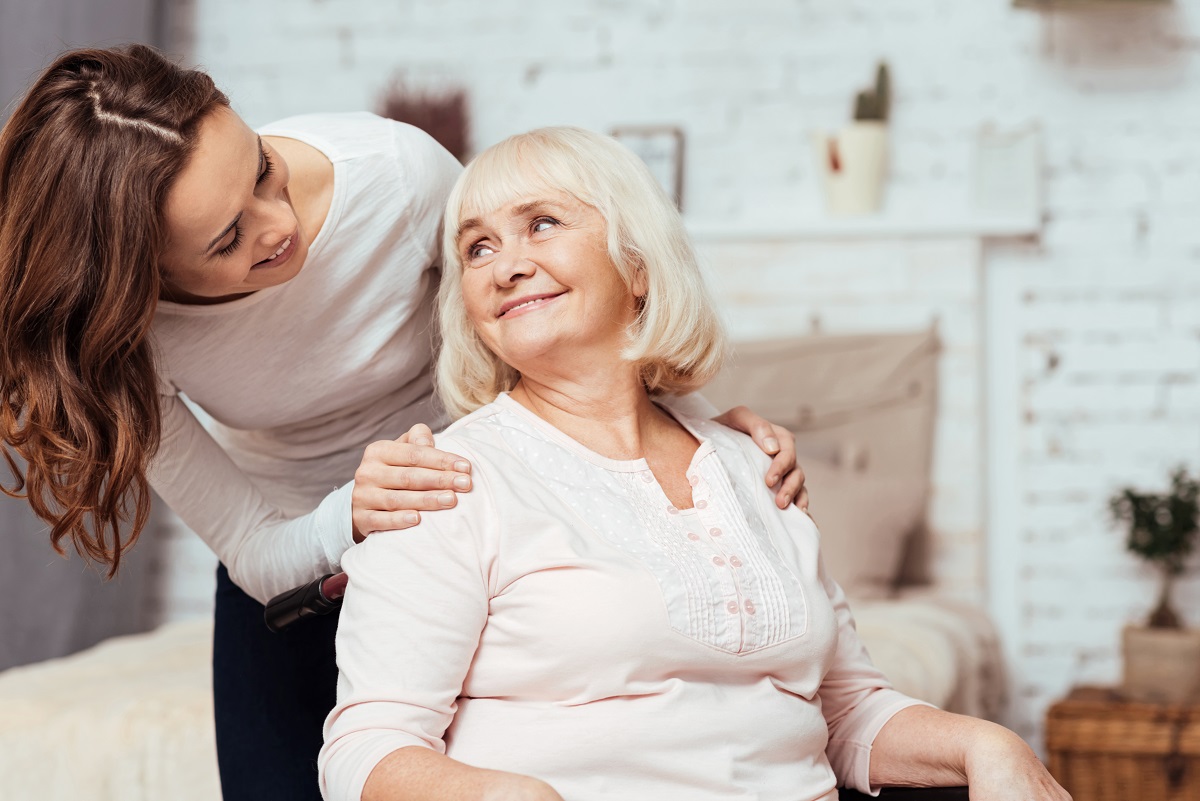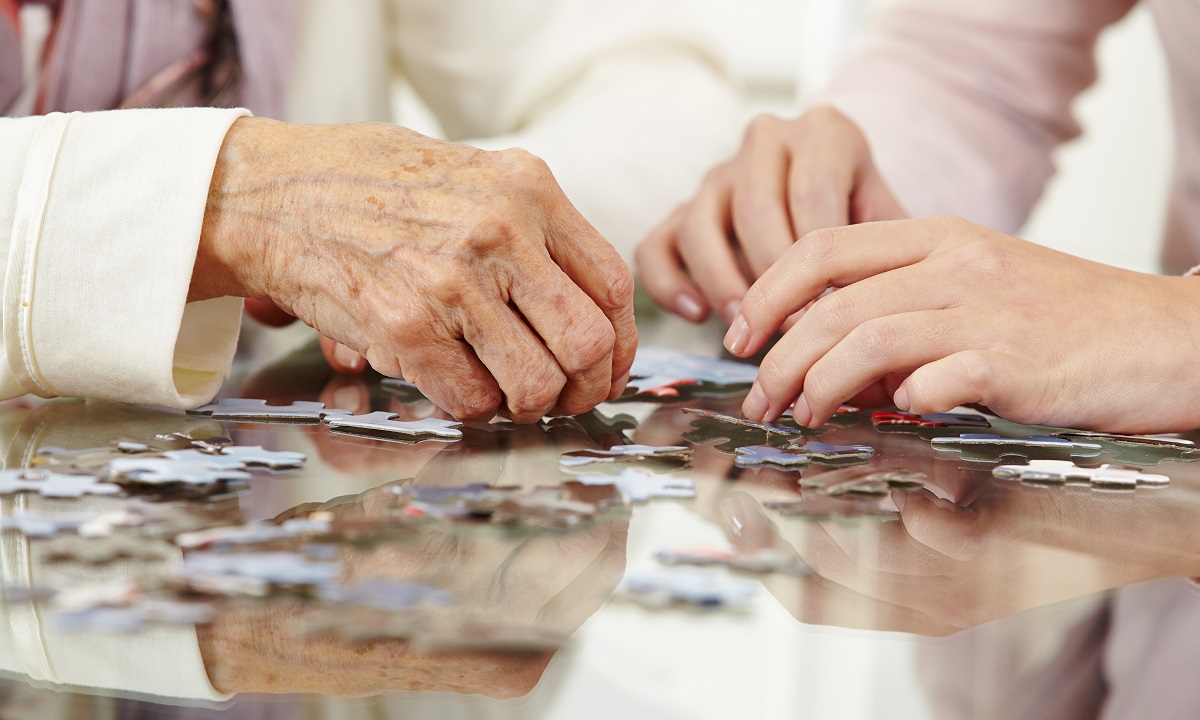Your dilemma
Your parent, partner or friend struggles to get themselves dressed and undressed each day, mainly because they lack the co-ordination or mobility to pull on trousers, do up shirt buttons, or reach round to pull up a zip. This can leave them feeling helpless, frustrated, embarrassed and undignified. They may suffer from incontinence, or struggle to get to the bathroom on time, and need clothes that are quick and easy to remove. Sore feet mean they can’t walk far and need comfortable shoes that can be slipped on easily, but are also secure and won’t cause a tripping hazard.
Trousers
Trousers can be notoriously difficult to pull on, especially if you’re trying to do it while standing up. They can also be fiddly to remove when you’re in the bathroom. Those with side zip openings create a wider opening through which to put your leg.
For men, front opening or ‘drop front’ trousers let you open up the trousers at the front, without having to pull them down, which provides easy access when using the toilet. Open-back trousers are useful for people who are wheelchair bound or need to sit down in order to put trousers on.
Shirts and tops
If the person you care for is struggling to do up fiddly buttons or get their arms through thin sleeves, there are adapted clothes that can help with this. These can include popper, Velcro and magnetic fastenings so that the shirt or blouse can be opened and closed quickly and easily.
Some shirts are opened through the back, which are ideal if you need to dress someone in a wheelchair, while others have special wider sleeve openings. Blouses with 3/4 length sleeves ensure can also be helpful.
Dresses
Twisting round to do up dresses can be notoriously difficult if your arms and shoulders are stiff, or you’ve lost some of the co-ordination needed to do it. Dresses that are wrap fastened, or open to the waist will be easier to do up or step into. Back opening dresses are easy for continence care.
Skirts
While skirts are a relatively easy item to put on, versions that have a wrap-round tie or elasticated waist can also help because it means you don’t have to bend down to step into it. An elasticated waist will make it comfier to wear, and skirts with long side-zips also make dressing easier.
Underwear
Maintaining someone’s dignity when they have dementia is vital, and this can be helped with adapted underwear. Side opening underpants and knickers make them much easier to remove when using the toilet, and also make them easier to change if the person you’re caring for has an accident.
Side and back opening vests are also useful to provide extra warmth under shirts and t-shirts, and are easy to put on and remove.
Bras
Bras can be extremely fiddly to put on and do up, especially those that fasten round the back, as it can be difficult to twist arms round. Front-fastening bras are much easier as you can see what you’re doing. For added comfort, go for non-wired bras.
Nightwear
Comfort at night can make a real difference if the person you’re caring for is waking frequently, which can be a particular problem for people with dementia. Making sure you’re loved one won’t wake up because they’re cold or uncomfortable is important.
Plus, if the person has to get up regularly in the night to use the toilet, it helps if the nightwear is easy to remove. Front and back button nightdresses and nightshirts are often easiest to put on and remove. Pyjamas can be adapted so they have side openings on the legs.
To keep someone warm, a bed jacket and bed bootees can be very useful additions to nightwear.
Socks
Circulation tends to get worse as you get older, and the extremities – hands and feet – are the first to suffer. A cosy, thick pair of thermal socks can be useful at night. If you’re worried about them slipping in them, go for varieties that have rubbery grips on the sole.
If the person you care for also has diabetes, or is prone to sores and blisters on the feet, diabetic socks, which are usually seam-free and won’t rub can be useful.
Swimwear
Swimming is a fantastic activity for older people because it is a non-weight bearing exercise, so it puts minimal strain on joints and muscles. The sensation of the water can be very relaxing and the action of swimming could even stir some dormant memories in the person you care for.
Make sure you’ve got the right swimwear if you do decide to take them swimming, particularly if they struggle with continence issues. Side zipper shorts make getting into them easier. You can get both ladies swimming costumes and men’s swimming shorts with built-in incontinence designs to allow for both liquid and faecal incontinence.
Shoes
Well-fitting shoes that are comfortable to wear are essential, especially if the person you care for is prone to walking around for a long time. You may not realise this, but feet tend to get bigger as you age, particularly in the width fitting, so picking wide fit shoes is useful. This is because the tendons and ligaments that link the many tiny bones in our feet start to lose elasticity. This allows the toes to spread out and the arch of the foot to flatten. Some over-40s can gain as much as one shoe size every ten years.
Some shoes are designed to be orthopaedic, which basically means that they’ll provide a lot more support than many standard shoes, particularly around the arch of the foot.
Many comfier fitting shoes feature thick soles with no or very low heel, soft upper material and Velcro fastenings so they’re easy to do up.
It’s important that shoes fit well as balance and co-ordination can become compromised for someone with dementia, and the last thing they need are shoes that slip off too easily, or have too high a heel.
Accessories
While the right accessory can make an outfit look smart (and many older people will be used to wearing smart accessories), they can be fiddly if co-ordination skills have declined since a dementia diagnosis. However, adapted accessories can help.
Anti-buckle belts look just like a regular belt, but rather than having to thread it through the buckle to fix it, you simply wrap it round your waist and it’s fixed with carefully hidden Velcro fastenings.
Likewise, if fastening a tie is starting to prove tricky you might want to consider a clip-on tie to solve this problem. A clip-on tie is a ready-formed tie that simply clips on to the top of the shirt, without you having to wrap it round your neck.
Hospital clothing
If the person you care for has to go into hospital for a while, they’ll need clothing that’s comfortable and easy to get in and out of. That means back opening nightwear, bed jackets and proper slippers with a grip.
Specialist
These are items that have been designed to deal with a specific issue, such as pressure sores, very bad circulation, or wheelchair clothing to help with dressing.
Pressure care clothing helps to support limbs if someone is bed bound, by creating a cushion around it. They can help to support heels and feet, which can be prone to sores. Lambswool bedding is also useful because it absorbs moisture and prevents the build-up of heat, which can lead to pressure sores.
If aching joints is an issue, cold weather can make them feel ten times worse, which not surprisingly affects mobility. Keeping joints warm can ease the achy pain, and there are special joint warmers which you can wrap around the joint to soften the muscles and tendons.
Thermal clothing and fleece blankets are useful if the person you care for regularly gets very cold while staying still.
Dressing aids can be very useful if the person with dementia wants to keep dressing themselves, but struggles with the more fiddly tasks such as putting arms through sleeves, putting on socks and shoes, doing up laces, hook buttons or zips or putting on a bra. Thankfully, there are devices or gadgets to help you cope with these, including sleeve aids, shoe horns and dressing sticks.
If the person you care for regularly uses a wheelchair, it’s important that they’re kept warm and dry. Wheelchair jackets and ponchos let you place the item over the user so they can still access the wheels if necessary without them being restrained. Special-grip gloves, which are also warm and waterproof can also be useful.
These products are good for…
Helping someone with dementia to dress themselves as much as possible, thereby maintaining their independence and helping them feel happier and more content. They can also aid dignity by making the dressing process as straightforward as possible.
Good to know
Dressing time can be a useful chance to have a chat with the person, particularly if they’re feeling awkward. You can talk to them about the weather, or even about a particular item of clothing that might remind them of something they wore when they were younger.
Tip
When helping someone with dementia to dress, lay out clothes in the order the person will put them on. Remind them sensitively which garment comes next, or hand them the next item that they need.
SHARE
Explore more




